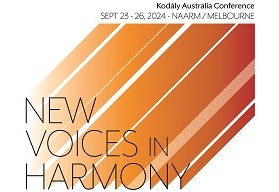Musicianship Tools
Hand Signs
Although generally credited to John Curwen, hand signs, as a form of musical notation, have been traced back as far as the ancient Hebrews and Egyptians. They were used effectively for many years in England and then later adopted by Hungarian teachers with a few minor changes. Hand signs are effective as a musical teaching tool because they visually and kinesthetically reinforce the high/low sounds and the intervallic relationships between the pitches being sung. Hand signs allow the teacher to see what the student is thinking especially when the classroom sound might be masking this.
Hand signs have time and again been shown to improve student intonation and pitch accuracy, particularly in the early stages of instruction. Hand signs are also extremely useful for advanced work – particularly when building harmonic awareness.
Hand signs are performed in front of the body and in line with the centre of the body. One hand or both hands (mirror image) may perform the hand signs. With smaller children, it may be best to have them use both hands, particularly if they are lacking in motor co-ordination. Sometimes, older students can also benefit from using both hands in the early stages, later reverting to single hands. With older students it is often a good idea to try a variety of ways and let them decide which is most comfortable for them.
Rhythm Syllables
Rhythm syllables are a tool for teaching and internalising rhythm. Using the rhythm syllable method, rhythmic patterns commonly occurring in Western European music are given a particular name that aids in their reading, writing. memorisation, dictation and performance. When used consistently, students develop the ability to aurally decode complex rhythmic patterns with ease and to sight-read rhythm patterns quickly.
This idea is not new and it is certainly not confined to Kodály teaching. In fact systems like this have been in use for many hundreds of years in Indian music (where it is called Bol) in Japan (where it is called kuchi shoga) and in African music. The Hungarian system was adapted from the work of the French musician and teacher, Emile-Joseph Chevé (1804-1864).
As a teaching tool, rhythm syllables are effective because they represent real sound with language offering the teacher a method to isolate the study of rhythm from that of pitch. However, music teachers sometimes reject rhythm syllables under the mistaken belief that the syllables impose a different or babyish name in place of proper theoretical names. This idea is false. Rhythm syllables are not really names, but expressions of duration. They are spoken/chanted and not written down as words. Their written form is the actual musical notes themselves.
The use of rhythm syllables does not excuse students from learning real theoretical names. Older students and those experienced with the syllables should be encouraged to learn both theoretical and rhythm names as both naming conventions operate in different domains. Theoretical names help in identifying, classifying and discussing rhythm. However, being able to name or identify something is not the same as internalising something as sound. Theoretical names do not help students understand what the rhythms sound like.
One-beat patterns (in simple time)
Two beat patterns (in simple time)
Compound time patterns
Sol-fa
Sol-fa [solfège-Fr., solfeggio-It.] is a system that uses syllables to represent the notes of the diatonic scale. This system aids in musical analysis, sight-singing and aural comprehension. Sol-fa was first developed as a teaching tool by Benedictine monk, Guido of Arezzo, who adapted it from a Latin hymn written around 770 A.D. However, in modern times, many have become familiar with sol-fa syllab
les through their immortalization in the Rogers and Hammerstein Musical, The Sound of Music. Sol-fa [solfège-Fr., solfeggio-It.] is a system that uses syllables to represent the notes of the diatonic scale. This system aids in musical analysis, sight-singing and aural comprehension. Sol-fa was first developed as a teaching tool by Benedictine monk, Guido of Arezzo, who adapted it from a Latin hymn written around 770 A.D. However, in modern times, many have become familiar with sol-fa syllables through their immortalization in the Rogers and Hammerstein Musical, The Sound of Music.
Sol-fa may be applied in one of two ways: In fixed ‘do’ form, the letter C is called ‘do’ regardless of the tonality of the music and regardless of any accidentals. This type of sol-fa is used in parts of Europe and as part of some training programs such as the Yamaha and Forte keyboard approaches.
In England, through the work of Sarah Glover and John Curwen, moveable do sol-fa (tonic sol-fa) became the favoured tool to teach singers to read music (sight sing). It was this form that was adopted by the Hungarian teachers and became a feature of the Kodály approach.
In tonic sol-fa, the tonic (key) note of any major scale is called ‘do’.
The tonic note of any minor scale is ‘la’ which preserves its relationship to the major scale and ensures consistency when labeling the intervals within the scale.
It is possible to chromatically raise or lower sol-fa syllables. A harmonic minor scale can be formed by raising the seventh note of the natural minor scale one semitone higher, thus ‘so’ becomes ‘si’.
Common scales with their corresponding sol-fa syllables
Ascending chromatic scale (using sharps)
Descending chromatic scale (using flats)
Melodic Minor scale
The Kodály Concept
Latest News
NEW Member Resources
I am pleased to announce the launch of a refreshed Kodály Australia Member Portal. All members of Kodály Australia may now use the Member Portal to access an online repository of resources and professional learning. To access these resources, please explore the branch …
Read more
ASME XXV National Conference 2025
The Australian Society for Music Education (ASME) XXV National Conference will be held from September 26 to 29, 2025, at the Queensland Conservatorium, Griffith University. The call for paper and workshop presentations has been extended until this Friday, 14 February 2025. As …
Read more
Season’s Greetings from Kodály Australia
As we near the end of 2024, I extend my warmest wishes on behalf of Kodály Australia for a joyful festive season and new year ahead. This year, there has been an extensive offering of professional learning activities provided for …
Read more
Congratulations Katharine Finlayson
Congratulations to Katharine Finlayson (ACT) who has been awarded Honorary Life Membership of Kodály Australia. Honorary Life Membership is Kodály Australia’s highest accolade and is given in recognition of an individual’s ongoing and highly significant contribution to the association and …
Read more
1000 Active Members!
Dear Members I am pleased to share that Kodály Australia recently recorded over 1000 active members in our database. This is an incredible achievement for our community and worthy of acknowledgement. Please know that your continued membership of Kodály Australia …
Read more










